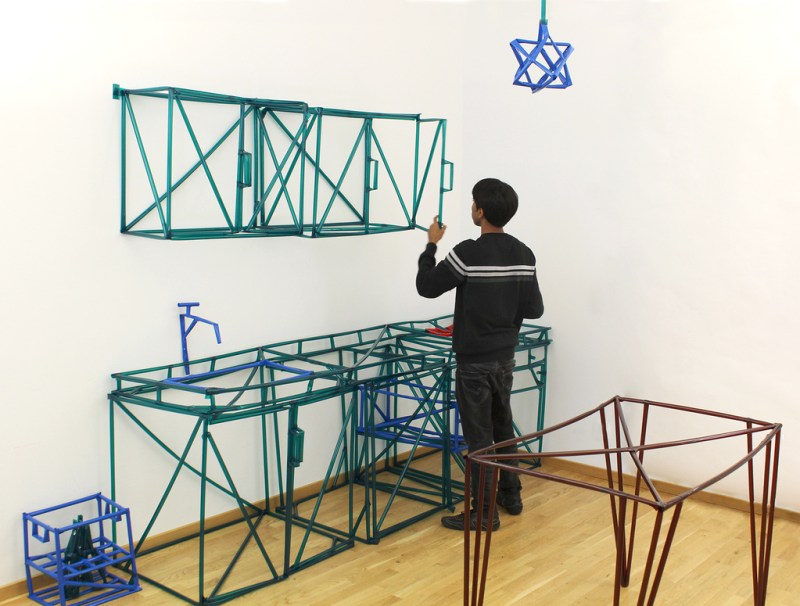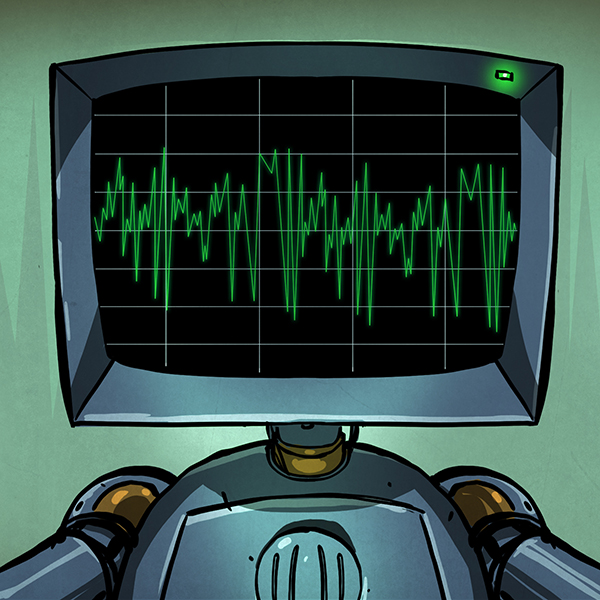Sometimes you just need a life-sized model. When you do, reach for your (highly modified) tape gun and get drawing.
As the Protopiper team describes it, the “gun” is a computer-aided hand held fabrication device for imagining layouts of large objects — the main example they give is furniture. Want to make sure that couch will fit? Why not spend 10 minutes building a tape model of it?
Sound crazy? Kind of, but the device itself is rather ingenious. It takes normal tape, measures it, and rolls it into tube form, which results in a surprisingly strong structure allowing you to build 3D shapes quite easily. From a design point of view it’s quite brilliant.
From the mechanism that rolls the tape into a structural tube to the winged end-connectors that allow you to easily attach to another tube or structure, the whole thing must have gone through many design iterations to get right. We’re impressed.
Alternatively for printing extremely large shapes, why not build a building sized delta-bot?
















I’m impressed too. Very clever. Well done!
Imagine if you had a thing like cans of “Great Stuff” foam attached to this
When the tube-making ends, the thing fills it in with foam and then closes the tape.
A few hours later, the foam’s solidified and can hold (some) weight.
Not strong enough for chairs or a couch, but might do for some light duty shelving, coat hanger rod, etc.
That is brilliant. The stuff expands like crazy, but as long as it didn’t pop the seams you’d be pretty strong. Kind of like how a water bottle is strong when full, weak when not.
But it WOULD pop the seams unless you used the “door & window” variety that wouldn’t add enough rigidity to overcome its own weight. I’ve used vast amounts of the various types of Great Stuff in my big remodeling project, and have been amazed by how much damage it can do if you’re not really careful about the amount you use and where you place it.
I watched 1 ” rivets on a ship rip out by someone over filling a hull void with two part foam. Impressive stuff
Interesting idea. Although there’s always a way. Perhaps something like a beanbag chair. This reminds me of those 3d printing pens. With the hot wire style cutting it does beg the question how long the batteries last. I suspect a blade might be a little more efficient.
Blade would cut better….. twice. Maybe 3 times. Source: box cutter at a grocery store far back in my youth. Would have killed for a hot knife.
But would a dull box cutter accomplish the killing needed to obtain the hot knife?
B^)
You can get a *lot* of hot-wire cutting done with even a fairly small LiPo battery pack. There’s not much thermal mass in the nichrome wire or the tape, so it doesn’t take much energy to heat up to cutting temperature.
This is an amazing project. Thanks for posting. Hope they post up design files!
“takes normal tape”
http://www.orafol.com/gp/americas/en/products/plotter-films-product-details-10187/items/oracal-8300-transparent-cal
To be fair, they say it would work well with some paper-based tapes, but they would not be able to use the hot-wire cutter.
I was most of the way to thinking; “meh. Tape and a roll former; my grandad did that in the 70s”
Then I saw the hot-wire cut-and-split mechanism. Holy Hotwire Batman! That’s a neat mechanism!
It’s so cute, but so impractical… A big wooden Tinkertoy-type set would be vastly less expensive (reusable parts, for one thing) and easier to work with. Even if you cut the sticks into disposable custom lengths like the tape gun does its plastic tubes, they’d still be much less expensive. For strength & rigidity similar to the plastic tubes, they could be thin enough that you could snip them with a hand tool and not need a messy saw (and note how much nasty smoke the plastic tubing cutter makes for each cut). Make ’em out of bamboo fibers and they’d be a lot “greener” than this plastic eater.
The “3D printer” obsession is making folks ignore good ol’ fashioned ways of accomplishing the same things.
I’m fun at parties, too.
+1
Wood would be less expensive than tape!? Besides that, where would you store your sticks when you’re not using them? Which would be most of the time. This is an interesting idea for what it does, delimiting bits of space. Dunno how much more practical it is that just imagining your new cupboards, and using a tape measure, but it’s a lot better than using bits of wood.
I really like that they put the display on the side to measure how much you had dispensed. Super useful feature.
My dick is hard.
Must be the tubes.
I lol’d
That’s really impressive. It’s almost a groobee (https://www.youtube.com/watch?v=5uSVM3tJVPk – the fun starts at 1:27)
Very Very Very cool. Super creative. Love the mechanism. Would buy these guys a beer for sure.
Imagine robots with industrial versions of that using stainless steel or titanium tape and welders for the joints. They could climb up the structure as they built it.
Reminds me of a modified factory robot that used welding rod to build structures like bridges.
https://vimeo.com/55657102
Video is of a different but similar robot.
The tubes are not curved, so more like this, http://grin.hq.nasa.gov/ABSTRACTS/GPN-2003-00108.html but perhaps with more complex triangulated surfaces.
I’ed love to see this thing using aluminum tape of some kind.
Here’s a more detailed description of the design: http://stefaniemueller.org/protopiper/
Good for space frames in a zero g environment. Seems to me I have seen it on some space construction video except they had it spewing out girders, so it must be like the seamless gutters “on a roll” meshed into a box shape.
In the 80’s someone invented a girder extruder that used rolls of flat metal then formed three strips with a lengthwise fold for the corners. One or two other strips were wrapped around the corner strips and fastened. I don’t recall if it used rivets or spotwelds.
The idea was to build space station girders on the spot in orbit instead of having to loft pre-built and very bulky sections of girder trusses. Of course NASA wasn’t interested, not enough to fly one on a Shuttle for a test.
Beef it up to use plumbers tape and a wirefed wielder and you could build just about anything. biggest downside would be the weight of the tool then.
That’s brilliant, now it only takes half an hour to build a mock sofa out of plastic instead of the drudgery of taking 3 measurements with a tape measure.
I’m impressed by the engineering, but seems this is a solution looking for a problem.
Some people are more visual than numerical.
And?
” Want to make sure that couch will fit? Why not spend 10 minutes building a tape model of it?”
Because it takes less than 1 minute to confirm with a tape measure, since all you need is the outer dimensions of the object.
Very cool idea. If they used a full-on crimper wheel system, they wouldn’t need adhesive on the material, and could then use regular plastic or even light metal rolled strips.
Watch out on the patents, though. The tube forming stencils look very much like serviette shaping forms, which apparently could not get patented because of pre-existing historical sword hilts that, perhaps, rolled cloth or ribbon as adornment? Nolo Press book on patents mentions this very case, I think.